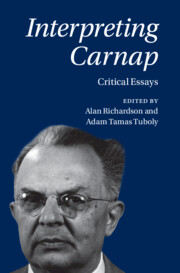Book contents
- Interpreting Carnap
- Interpreting Carnap
- Copyright page
- Contents
- Contributors
- Acknowledgments
- Abbreviations
- Introduction
- Part I Philosophy in New Dress
- Part II Naturalism and Method
- Part III The Logical and the Linguistic
- Chapter 8 Carnap’s Approach to Semantics and Syntax
- Chapter 9 Carnap on the Formality of Logic and Mathematics
- Chapter 10 Carnap on Probability and Induction
- Chapter 11 Metaphysics, Tolerance, and Language Planning
- Part IV Science and Theories
- Bibliography
- Index
Chapter 8 - Carnap’s Approach to Semantics and Syntax
Relations and Tension
from Part III - The Logical and the Linguistic
Published online by Cambridge University Press: 01 February 2024
- Interpreting Carnap
- Interpreting Carnap
- Copyright page
- Contents
- Contributors
- Acknowledgments
- Abbreviations
- Introduction
- Part I Philosophy in New Dress
- Part II Naturalism and Method
- Part III The Logical and the Linguistic
- Chapter 8 Carnap’s Approach to Semantics and Syntax
- Chapter 9 Carnap on the Formality of Logic and Mathematics
- Chapter 10 Carnap on Probability and Induction
- Chapter 11 Metaphysics, Tolerance, and Language Planning
- Part IV Science and Theories
- Bibliography
- Index
Summary
A few years after his adoption of both a syntactical method and a principle of tolerance in the early thirties, Carnap turned to semantics when he learned about Tarski’s work on the definition of a truth predicate. How significant is this semantical turn? Carnap scholars have so much emphasized that The Logical Syntax anticipates Tarskian semantics that they tended to minimize the importance of Carnap’s adoption of a semantical approach. As a consequence, his semantical turn has not always been given the importance it deserves. Its meaning, scope and consequences have also often been misunderstood. This paper contributes to a re-evaluation of Tarski’s influence on Carnap in view of the fact that Carnap is far from having just followed Tarski’s way. We examine some specificities of Carnap’s approach of semantics. We also discuss what is left of the syntactic method after the adoption of semantics and what the relations between syntax and semantics become from the late thirties on. The following topics are given specific attention: languages, formal systems, and calculi; truth, L-truth, and L-validity; L-states, L-ranges, and state descriptions. We also analyze the impact of semantics on the principle of tolerance.
Information
- Type
- Chapter
- Information
- Interpreting CarnapCritical Essays, pp. 153 - 170Publisher: Cambridge University PressPrint publication year: 2024
Accessibility standard: Unknown
Why this information is here
This section outlines the accessibility features of this content - including support for screen readers, full keyboard navigation and high-contrast display options. This may not be relevant for you.Accessibility Information
- 1
- Cited by
